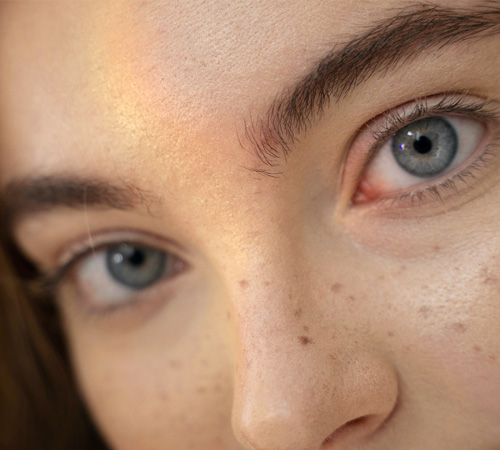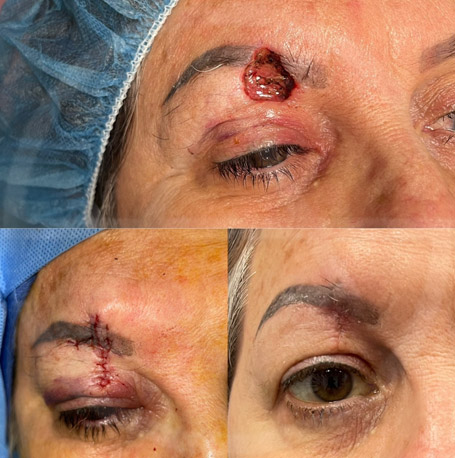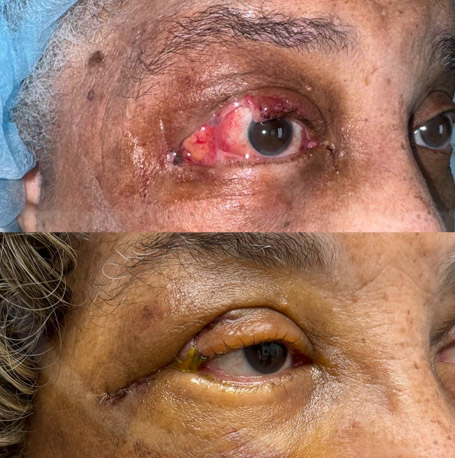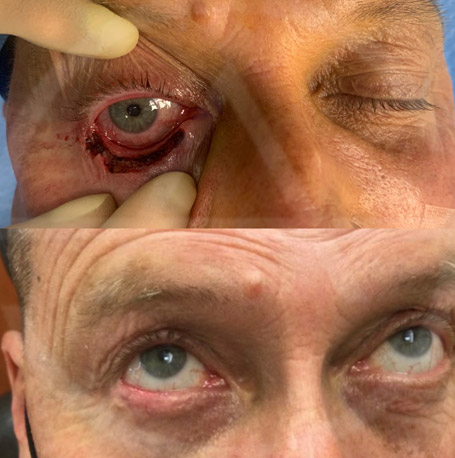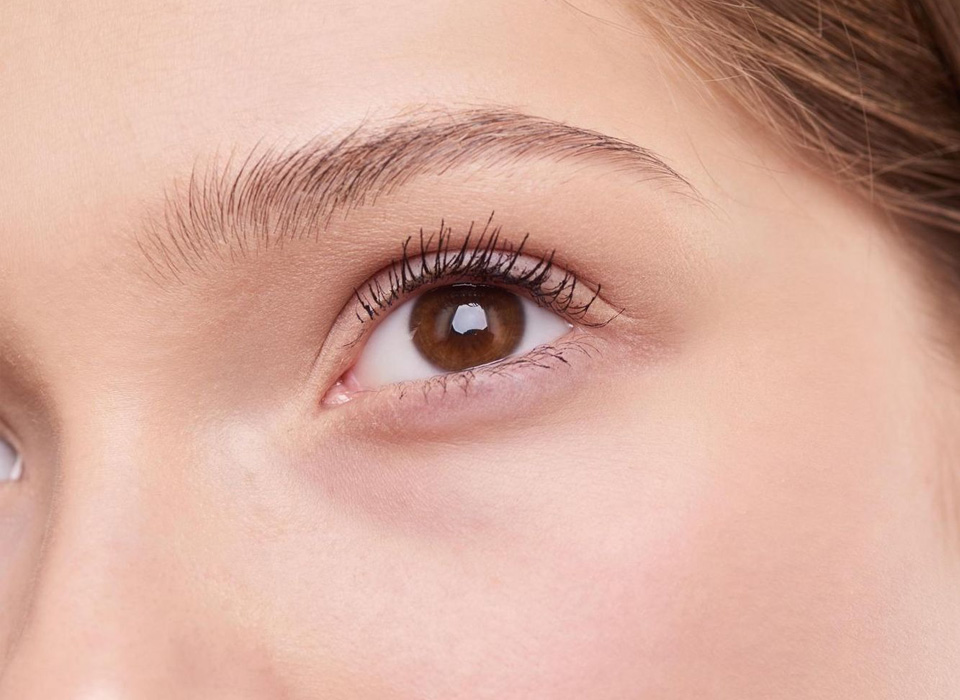
Skin Cancer Reconstruction After Mohs Surgery
Table of ContentsToggle Table of ContentToggle
How Do Oculoplastic Surgeons Treat Skin Cancer on the Face and Eyelids?
The treatment of skin cancer on the face requires a specialized approach to ensure complete removal of the cancer while minimizing cosmetic and functional impact. Oculoplastic surgeons and Mohs surgeons often collaborate when a patient has skin cancer, especially if the cancer affects the eyelid or the area around the eye, as oculoplastic surgeons are highly specialized in treating conditions affecting the eyelids and the surrounding areas. This collaboration ensures that the cancer is effectively removed while preserving the eye’s function and maintaining the best possible cosmetic outcome.
What Is Mohs Micrographic Surgery?
Mohs surgery is a highly precise technique used for treating skin cancer, especially on the face. It is done by a dermatologist trained in Mohs micrographic Surgery, and it involves removing the cancer layer by layer, examining each layer under a microscope, and stopping only when no cancer cells are found. Mohs surgery preserves as much healthy tissue as possible, making it particularly well-suited for facial skin cancer. Oculoplastic surgeons and Mohs surgeons often collaborate when a patient has skin cancer, especially if the cancer affects the eyelid or the area around the eye. This collaboration ensures that the cancer is effectively removed while preserving the eye’s function and maintaining the best possible cosmetic outcome. After the Mohs surgeon has removed your skin cancer, Dr. Sarah Avila will then proceed with the reconstruction the same day or the following morning.
How Do Oculoplastic Surgeons and Mohs Surgeons Work Together?
- Initial Evaluation and Diagnosis: The process begins with an initial evaluation by diagnosing the skin cancer and assessing its type, location, and extent.
- Mohs Micrographic Surgery: If the skin cancer is located in a sensitive area like the eyelid or has complex features, a Mohs surgeon will perform Mohs micrographic surgery. This precise technique removes cancer layer by layer and examines each layer under a microscope to ensure complete removal while sparing healthy tissue.
- Collaboration and Consultation: If the cancer is close to the eyelids, the Mohs surgeon and oculoplastic surgeon will work together for best results.
- Skin Cancer Removal: The Mohs surgeon performs the initial surgery to remove the skin cancer. During this process, the Mohs surgeon systematically removes cancerous tissue while minimizing the impact on healthy tissue.
- Evaluation of Surgical Defect: After the cancer is removed, the size and depth of the surgical defect are assessed. This information is crucial for planning the reconstruction.
- Reconstruction Planning: The Mohs surgeon collaborates with the oculoplastic surgeon to plan the reconstruction of the surgical defect. The oculoplastic surgeon specializes in eyelid and periocular reconstruction and ensures that the functional and cosmetic aspects of the eye are preserved.
- Eyelid Reconstruction: The oculoplastic surgeon performs the eyelid reconstruction, employing various techniques to restore the eyelid’s function and appearance. This can involve primary closure, local tissue flaps, skin grafts, or other specialized procedures.
- Post-Operative Care: After the reconstruction, the patient receives post-operative care, which may involve managing swelling, bruising, and wound care. Close follow-up appointments are scheduled to monitor the healing process.
- Cosmetic and Functional Outcomes: The collaboration between the Mohs and oculoplastic surgeons aims to achieve the best possible cosmetic and functional outcomes, ensuring the patient’s well-being and satisfaction.
- Long-Term Care: Patients with a history of skin cancer may require long-term follow-up and surveillance to monitor for any signs of recurrence or new skin cancers.
The collaboration between Mohs surgeons and oculoplastic surgeons allows for a comprehensive and specialized approach to the treatment of skin cancer in the delicate areas around the eye. This multidisciplinary teamwork ensures that cancer is effectively removed while maintaining the eye’s function and preserving a natural appearance.
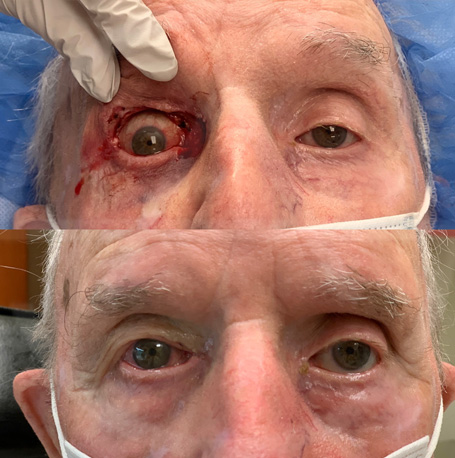
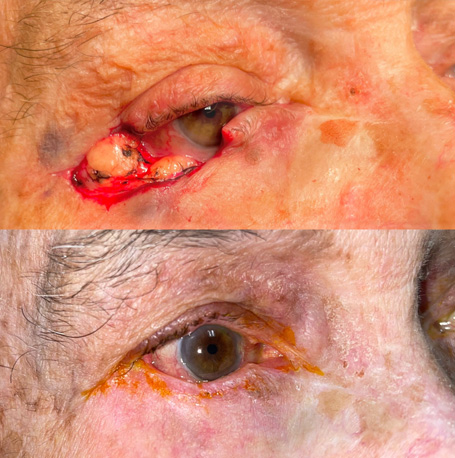
What Are the Alternatives to Skin Cancer Surgery?
- Radiation Therapy: For some cases where surgery is not ideal due to location or other factors, radiation therapy may be used. It involves targeting the cancer with high-energy radiation to kill the cancer cells.
- Topical Treatments: Certain topical treatments, such as imiquimod or fluorouracil, may be prescribed for superficial skin cancers, especially on the face.
- Laser Therapy: Laser therapy uses high-energy light to target and destroy cancer cells. It’s suitable for some superficial skin cancers.
- Medication: Depending on the type of skin cancer you have, there are new medications that could be used to help cure or decrease the cancerous cells.
The choice of treatment depends on the type of skin cancer, its size and depth, and its location on the face. Facial skin cancer treatment often requires a multidisciplinary approach, involving dermatologists, oncologists, plastic surgeons, and other specialists to provide the best outcome in terms of cancer removal and cosmetic results. If you suspect skin cancer on your face or have been diagnosed with it, consult with a healthcare professional who specializes in skin cancer for a thorough evaluation and personalized treatment plan.
How Can I Prevent Skin Cancer on the Face and Eyelids?
Preventing skin cancer on the face and eyelids involves taking proactive steps to minimize sun exposure, protect your skin from harmful UV radiation, and regularly monitor your skin for any changes. Here are some strategies to help prevent skin cancer in these areas:
- Sun Protection: Apply a broad-spectrum sunscreen with an SPF of 30 or higher to your face, including your eyelids, every day, even on cloudy days. Use sunglasses that provide 100% UVA and UVB protection to shield your eyes and the delicate skin around them from harmful UV rays.
- Protective Clothing: Wear wide-brimmed hats to protect your face, including the eyelids. Use clothing that covers your skin, such as long sleeves and pants made from UPF (ultraviolet protection factor) fabric.
- Regular Self-Exams: Routinely examine your face and eyelids for any new moles, growths, or changes in existing skin spots. Be vigilant about any spot that is asymmetrical, has irregular borders, changes in color or size, or is itchy, painful, or bleeding. These can be potential signs of skin cancer.
- Annual Skin Checks: Schedule regular skin checks with a dermatologist, especially if you have a history of skin cancer, a family history of skin cancer, or numerous moles.
- Maintain a Healthy Lifestyle: A balanced diet, regular exercise, and overall good health can contribute to strong skin and a reduced risk of skin cancer.
- Quit Smoking: Smoking can increase the risk of certain skin cancers, so quitting is beneficial for overall health and skin cancer prevention.
- Be Mindful of Medications: Some medications can make your skin more sensitive to sunlight. If you are taking such medications, take extra precautions when exposed to the sun.
Remember that early detection is key to successful treatment of skin cancer, so if you notice any changes on your face or eyelids, consult a doctor promptly. Regular sun protection and self-examinations can significantly reduce your risk of skin cancer in these sensitive areas.

Sarah Avila, MD
Specialization: Eyelid Surgery & Aesthetics
Dr. Sarah Avila is an oculofacial plastic surgeon in Miami, Florida. After completing medical school, Dr. Avila completed a residency in ophthalmology at the Mount Sinai Hospital, followed by a highly competitive two-year ASOPRS-accredited fellowship in reconstructive and cosmetic oculofacial surgery at Emory University. During this fellowship, Dr. Avila focused on plastic surgery related to the eyelids, brows, lacrimal duct system, orbit, and face.


